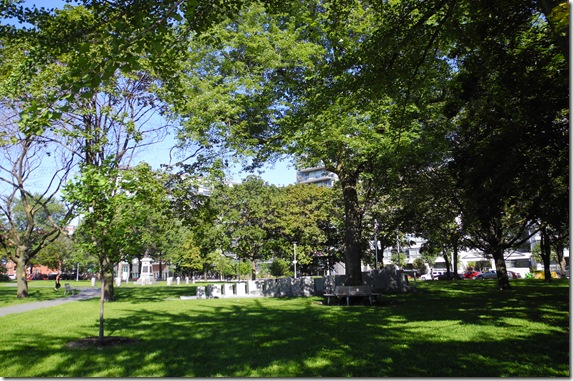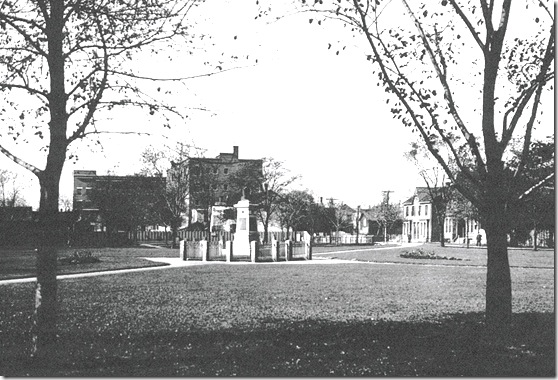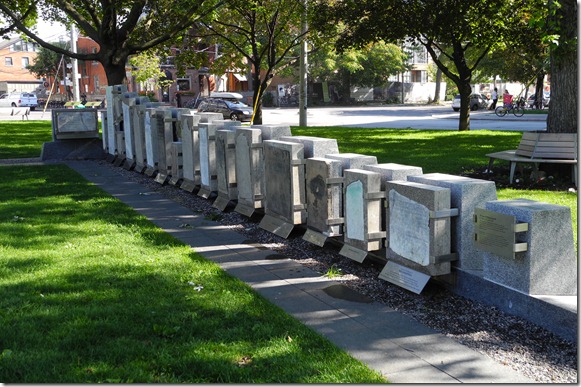Victoria Memorial Square today
Victoria Memorial Square on 14 October 1913 (City of Toronto Archives)
The Garrison Burying Ground
Toronto’s first cemetery, the Garrison Cemetery, today named Victoria Memorial Square, is located in the Kings West District. It is one block south of King Street, between Bathurst and Spadina.
To clear the land for the cemetery, trees were cut down by Simcoe’s troops. When the first internment occurred in 1794, it was entirely surrounded by dense forest. Governor Simcoe’s daughter, Katherine, only fifteen months of age when she died, was the first to be buried in the cemetery. During the years a head many more were placed within its grounds, including at least one of the soldiers who perished defending York in the American invasion of 1813. During the War of 1812, York was a medical centre where they brought those who had been injured in battles on the Niagara frontier. Reverent John Strachan reported that in 1813 he officiated at the funerals for six to eight men a day.
In the 1830s, when the land was surveyed and streets laid out, the small square was bounded on the north by Stewart Street, on the south by Niagara Street, the east by Portland Street, and to the west by Bathurst Street. During the years ahead, houses were erected on its western section (on Bathurst Street), reducing the size of the Square. Thus, the open space was larger in the nineteenth century than it is today. The east side of the cemetery was where the street known as Wellington Place ended. Eventually a street was cut through the square but was named Douro. Douro and Wellington Place were eventually combined and renamed Wellington Street West, as it is today.
The boundaries of the burial ground within the square formed a rectangle, with the corners pointing to the four cardinal points of the compass. This was unusual as it was the custom of the day to align plots parallel to the grid. Almost all streets were also planned according to the grid lines. The reason for the unusual configuration of the cemetery is today unknown. At that time, the only other site in the community that was positioned in a similar manner was “Bell Vue,” the home of the Denison Family, located in Denison Square in the present-day Kensington Market area.
It is estimated that from the time of its inception in 1794 until the final interment in 1863, about four hundred bodies were placed within the grounds. In the years ahead citizens of the town were also buried here, though after 1807 many were placed in the churchyard of St. James, on King Street East. With the closing of the First Garrison Burying Ground, another cemetery was created to the northwest of Fort York, on Dufferin Street, near the present-day Canadian National Exhibition grounds.
It is worth mentioning a few of those who were buried in the Garrison Cemetery. Most of the names that follow were identified by John Ross Robertson during visits to the cemetery in the 1870s. They were recorded in his book “Landmarks of Toronto, Volume 1.”
Christopher Robinson, died 1798, father of John Ross Robertson.
Benjamin Hallowell, a relative of Chief Justice Elmsley, died Thursday, March 28, 1799, age 75.
John Edward Sharps, infant son of J. E. and M Sharps, died at 9 months on August 8, 1813.
Captain McNeal killed in the Battle of York, 1813, during the American invasion of Toronto.
Charlotte, wife of John Armitage, died April 8, 1819.
John Saumariez Colbourne, died May 1, 1826, three-year-old son of Sir John Colbourne.
Mackay John Scobie, died August 26, 1834, age 18, and his brother Kenneth Scobie, age 25, died in 1834. Their father was Captain John Scobie of the 93rd Highlanders.
Margaret Ryan, wife of William Ryan of the Canadian Rifles, died 1835.
Lieutenant Zachariah Mudge, private secretary to Sir John Colbourne (Lord Seaton), committed suicide by placing a gun to his chest. He died at age 31 on June 10,1831.
Barbara Mary, daughter of Reverend J. Hudson, died July 17, 1831.
Archibald Currie of Glasgow, Scotland. Robertson states that the stone was too corroded to decipher any other details.
Final burial in the Garrison Cemetery was Private James McQuarrick in 1863.
An interesting notation claims that Captain Battersby, a British soldier, when ordered back to Britain following the War of 1812, shot his two horses and buried them in the cemetery, rather than part with them by selling them to someone else. Thankfully, he did not plan a similar fate for the friends he left behind in tiny York.
Restored headstones in Victoria Memorial Square today
I have spent much of my adult life researching and photographing Toronto. I love the city. It has provided the background for my books, one of which, “The Villages Within”, was nominated for the Toronto Heritage Awards. If interested in novels with a Toronto setting, descriptions of the books are available by following the link: https://tayloronhistory.com/2012/03/22/toronto-author-publishes-seventh-novel/
They can be purchased in soft cover or electronic editions. All books are available at Chapters/Indigo and on Amazon.com. The electronic editions are less that $4. Follow the links:
There Never Was a Better Time: http://bookstore.iuniverse.com/Products/SKU-000056586/THERE-NEVER-WAS-A-BETTER-TIME.aspx
Arse Over Teakettle: http://bookstore.iuniverse.com/Products/SKU-000132634/Arse-Over-Teakettle.aspx
The Reluctant Virgin; http://bookstore.iuniverse.com/Products/SKU-000188306/The-Reluctant-Virgin.aspx
The Villages Within: http://bookstore.iuniverse.com/Products/SKU-000175211/The-Villages-Within.aspx
Author’s Home Page: https://tayloronhistory.com/
Authors can be contacted at: [email protected]


